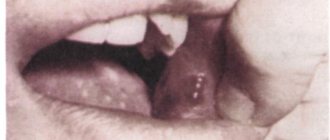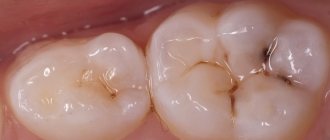Why do teeth marks appear on the tongue and what to do about it?
If you notice teeth marks on your tongue, then this symptom should alert you. We must not forget that the tongue is a mirror of the body. It is through this organ that signals about various pathologies and diseases that require treatment can be received. We will talk about the most common of them in our article today.
Malocclusion
If teeth marks and imprints on the sides appear on a muscular organ with enviable frequency, then we can assume that bite pathologies are to blame. Incorrect occlusion, displacement of the jaws and their asymmetrical arrangement relative to each other, crooked and crowded elements in the oral cavity are prerequisites for the emergence of a problem.
On a note! Depending on the type of pathology, tooth marks can appear along the edges of the tongue, at the tip, or at the root. The problem appears for the reason that when the jaws close, the muscular organ involuntarily tries to take a position corresponding to the location of the dentition.
When a person has an incorrect bite, the process of chewing food is disrupted, speech is difficult, the enamel is quickly erased, and the height of the crowns decreases. In this regard, situations arise when not only strong teeth marks appear on the tongue, but also chronic injuries in the oral cavity, ulcers and wounds caused by biting the mucous membrane and the muscular organ itself.
Etiology - causes of tongue cancer
The main cause of tumors on the tongue, like any other cancer, is a genetic malfunction in the cells.
In this case, these are epithelial cells - the tissue that forms the mucosa. Several main factors contributing to this process have been identified:
- Exposure to carcinogens. A huge amount of harmful substances is contained in cigarette smoke and chewing mixtures (nasvay, betel). It is in smokers and nasal users that cancer of this localization is most often diagnosed, and in men it is detected 3 times more often than in women. Alcohol increases the impact of carcinogens.
- Occupational hazards. The incidence of tongue cancer in people employed in hazardous industries is much higher. Salts of heavy metals (mercury, lead), asbestos, and petroleum products can also be classified as carcinogens by their nature.
- Photo: neoplasm on the tongue
Impact of viruses. Recent studies have proven a direct link between chronic viral infection and the incidence of cancer. Human papillomavirus, herpes simplex virus and HIV are capable of transforming the genome of cells, turning them into cancerous ones. According to statistics, up to 70% of women are carriers of HPV. The mechanism of oncogenic effects of viruses is associated with their ability to suppress antitumor genes.
- Chronic oral injuries. They may be associated with improper installation of dentures, improper treatment of fillings, or chronic biting of the mucous membrane.
Long-term exposure to these factors on the mucosa is accompanied by damage to the DNA structure of epithelial cells. As a result, papillary hyperplasia (excessive growth) develops, which looks like a thickening at the sides, or dysplasia (improper development) of the mucous membrane.
Further exposure to these causes leads to the development of precancerous conditions: leukoplakia, Bowen's disease, hyperkeratosis and papillomas. Subsequently, these conditions transform into oncology.
Other dental problems
When teeth imprints constantly appear on the tongue and cheeks, while a person manages to bite and injure the mucous membrane, this can indicate not only malocclusions, but also other dental pathologies:
- incorrectly installed crowns, fillings and dentures,
- presence of chipped and damaged teeth,
- abnormal structure of the temporomandibular joint,
- bruxism,
- lack of teeth,
- anomalies in the growth and eruption of third molars: for example, “eights” can grow into the cheek, cause crowding of the row and provoke bite pathologies.
Main non-dental causes
Tongue diseases
If you notice an enlarged tongue with teeth marks in yourself or your child, then you should look for the problem in inflammation of the muscle organ. Often the cause of the pathology is a disease such as glossitis. There are many types of glossitis: desquamative, allergic, herpetic, ulcerative, hypertrophic, folded - read in detail about all types and forms in the feature article on the website.
When glossitis appears, other characteristic symptoms usually occur, in addition to the fact that tooth marks remain on the tongue:
- burning and itching of the muscle organ,
- redness, the appearance of plaque of different shades,
- pain and discomfort when eating food, when communicating with others,
- change in relief and structure: formation of cracks, ulcers, grooves, spots, erosions.
The causes of glossitis are very diverse: injuries, weak immunity, active reproduction of viruses and bacteria in the oral cavity, allergic reactions to personal hygiene products, medications and food.
Xerostomia (dry mouth)
A swollen tongue with teeth marks is often noticed by people who have impaired normal salivation. Xerostomia can occur in older people, as well as in those who take various medications for a long time. In some cases, the pathology is associated with dysfunction and inflammation of the salivary glands, autoimmune diseases (for example, Sjogren's syndrome), and hormonal disorders.
Another reason is dehydration after diseases accompanied by intoxication and high body temperature (poisoning, sore throat, influenza, ARVI and many others). Xerostomia affects people with diabetes, as well as those who frequently smoke and drink alcohol.
On a note! Sometimes dry mouth is normal. For example, the rate of salivation naturally decreases at night, which is why many people notice bad breath and teeth marks on the tongue after sleep. The problem can also appear after exhausting physical activity, sports, prolonged stay in stuffy rooms and in the open sun.
With a lack of saliva, the muscular organ becomes dry, may turn red, swell and increase in size, after which imprints appear on it and cracks appear. There are other signs of xerostomia:
- halitosis: bad breath,
- viscous and thick saliva,
- difficulty chewing and swallowing dry food,
- thirst.
If the problem of chronic xerostomia is not addressed, caries will progress, as well as other dental diseases (erosions, gingivitis and periodontitis, candidiasis). After all, the lack of a sufficient amount of saliva leads to the active proliferation of bacteria in the oral cavity and increased accumulation of plaque on the enamel, gums, and also under the gums.
Nervous disorders and stress
Teeth imprints on the sides of the tongue may indicate excessive nervous excitability and that the person has recently been in a stressful or conflict situation, experienced severe psycho-emotional shock, or is in a depressed state. Under nervous overload, you can involuntarily clench your jaws, squeeze the muscular organ between the lower and upper jaws, bite it, after which marks appear on its surface.
In rare cases, the problem indicates neurological disorders and neuroses, epileptic seizures in which a person cannot control himself. But then the patient not only bites a muscle organ, but can severely injure it, disrupt the integrity of the mucous membrane and tissue covering it, and cause bleeding.
Malfunction of the hypoglossal nerve
When an organ is displaced and occupies an unusual location for it, then teeth marks appear on it, as in the photo. Such an unpleasant phenomenon may be associated with pathological damage to the hypoglossal nerve resulting from a massive stroke or multiple sclerosis.
Pathologies of the gastrointestinal tract
A dense plaque of white, yellow or brown color appears, and after closing the jaws, tooth marks remain on the tongue if there is any disease of the gastrointestinal tract: gastritis, ulcers, colitis, pancreatitis, dysbacteriosis, acidity disorders.
Usually, with these pathologies, the patient is accompanied by halitosis, and plaque cannot be permanently removed with a brush and paste, since it constantly accumulates again. There are other characteristic symptoms of gastrointestinal pathologies: bloating, pain, stool disturbances, nausea, heaviness in the abdomen.
Endocrine system dysfunction
If a muscular organ has increased in size and swollen, and there are imprints of chewing teeth on it, then what does this mean? Perhaps an advanced stage of hypothyroidism, when the thyroid gland does not secrete enough hormones. Patients with this disease usually notice not only swelling of the muscle organ, but also swelling of the face and neck. Their hair begins to grow and fall out, their nails peel, their diction is impaired, their blood pressure and pulse rise, arrhythmia occurs, and their voice becomes hoarse.
Acute deficiency of vitamin B3 and nicotinic acid
Due to the lack of these substances in the body, a rare form of vitamin deficiency develops, which doctors call pellagra. The disease is quite rare, because vitamin B3, as well as nicotinic acid, are contained in almost all products that we, one way or another, consume: eggs, milk, all types of meat, liver, fish, carrots, potatoes, tomatoes, wheat. Experts believe that the pathology mainly occurs in people from disadvantaged environments and those who abuse alcohol.
With pellagra, the muscle organ swells, and therefore teeth marks periodically appear on the tip of the tongue or on its sides. There is a feeling of discomfort and burning in the mouth, the mucous membranes and gums itch, hurt, and itch. This disease brings with it many others: dementia, dermatitis, nervous disorders, paralysis of the limbs, dysfunction of the cardiovascular system.
Important! Teeth imprints on the tongue may indicate various diseases: hemolytic anemia[1], scarlet fever, cancer, tuberculosis, HIV. A swollen muscle organ on which imprints remain is sometimes a consequence of acute allergic reactions and Quincke's edema.
Diagnostics
On your own, you can only suspect the first symptoms of oncology in a given localization. Strangely enough, the doctors who most often encounter this pathology are not oncologists, but dentists. This is due to the specifics of their activity - in the course of their professional activities, they may be the first to notice signs of an early stage of cancer in the form of a lump on the side of the tongue or at the root.
The similarity of the first symptoms of tongue cancer with other diseases of the oral cavity leads to its late diagnosis - most often at the second stage, when a malignant neoplasm of the mucous membrane takes the form of an ulcer or a pronounced tumor.
Specific diagnostics consists of the following examinations:
- Examination of a fingerprint smear to detect signs of squamous cell carcinoma.
- Tumor biopsy followed by histological examination under a microscope.
- Ultrasound of the tongue and soft tissues of the lower jaw, as well as ultrasound of the neck to search for metastases.
- X-ray of the skull or computed tomography - if there is a suspicion of tumor growth into the bone.
In order to exclude distant metastases, it is necessary to do an X-ray of the lungs, CT (MRI) of the brain and ultrasound of the liver.
Despite the fact that squamous cell carcinoma of the tongue is less common in women, the frequency of its detection at an early stage is much higher in them. This is due to the more sensitive attitude of women to the condition of the oral cavity.
Why does the problem occur in pregnant women?
Teeth imprints on the tongue during pregnancy may be associated with the pathologies that we listed earlier, but most often they appear for the following reasons:
- dehydration of the body against the background of severe toxicosis,
- iron deficiency anemia: the muscle organ becomes red, swollen and numb,
- candidal stomatitis: then the unpleasant symptom is accompanied by the appearance of a dense cheesy coating,
- lack of B vitamins and folic acid,
- physiological swelling of organs due to the accumulation of fluid in the body in late pregnancy.
“I constantly noticed this problem during pregnancy. Especially after I get nervous. It was very noticeable in the later stages, in the summer, in the very heat. I was also constantly thirsty, I always felt that my mouth was very dry, and my tongue was swollen as a result. And I drank water and drank... True, the doctor scolded me all the time, saying that my whole body and all my internal organs were swelling. As soon as I gave birth, everything returned to normal...”
Anastasia K., review from woman.ru
Associated symptoms
People who have imprints of their front or chewing teeth on their tongue often notice other alarming signs indicating pathological conditions:
- the muscular organ swells and increases in volume, becomes inflamed, changes its color, cracks, sores, erosions and spots appear on it,
- plaque formation: the density of plaque may depend on various factors - time of day, stage of development of a particular disease, nature of food consumed, frequency and thoroughness of hygiene procedures,
- it is difficult and painful to eat food, swallow it, talk,
- displacement of the tongue to the side, inability to control its position.
Some experts believe that if prints appear on the tip of an organ, this may indicate excessive nervous excitability and stress. If on the sides, then most often it indicates malocclusion pathologies, dental problems, diseases of the gastrointestinal tract, and pathologies of the endocrine system.
Swollen lips
As mentioned above, the tongue and lips most often swell at the same time due to allergies. In this case, swelling occurs rapidly, literally in a matter of minutes. Along with a swollen tongue, the patient may experience other unpleasant symptoms, such as a runny nose, sneezing, mild cough, vomiting and abdominal pain. If no measures are taken, then other symptoms may appear a little later - such as increased body temperature, changes in body color and sensitivity, and soreness and swelling of the tongue.
Many in this situation are lost and do not know what to do if the tongue is swollen and the patient apparently has an allergic reaction. You should not panic, you need to act quickly and clearly. You need to urgently call an ambulance, and before it arrives, give the patient an antihistamine, open the windows wide and provide access to fresh air, and avoid contact with the allergen (if known).
Removing fingerprints at home
Marks or imprints on the tongue are especially noticeable when there is plaque. To get rid of the problem, you can thoroughly clean the surface of the muscular organ with a brush or a special scraper. Afterwards, it is recommended to rinse the mouth well with water and mouthwash. Any antiseptic, soda solution, as well as herbal decoctions are also suitable for rinsing - all this is especially important if there are not only traces on the mucous membrane, but also ulcers, wounds or cracks, bleeding, if you are bothered by bad breath.
If the mucous membranes are dry, caused by dehydration or extreme heat, it is recommended to drink more liquid, in particular plain water, fruit drinks, and herbal teas. This will help restore the water-salt balance and normalize salivation, as well as get rid of the feeling that the tongue is swollen.
It is important to understand here that if the problem is pathological, then after a short period of time you will again notice marks on the tongue, a large accumulation of plaque and other associated symptoms. In this case, you will be able to get rid of the pathology only when you cure the underlying disease, which means that you will first have to see a doctor.
Treatment methods for tongue cancer
Regardless of the cause of tongue cancer, combination therapy is used to treat it, including the following methods:
- Surgery. The operation is aimed at radical removal of a malignant tumor: either partial resection (excision) of the tongue or its complete removal (glossectomy) is performed. In advanced cases, when the tumor has grown into the surrounding tissues, they are resected down to the bones of the lower jaw.
- Radiation therapy. There are remote therapy, when the tumor is irradiated at a distance with X-rays, and contact therapy (brachytherapy), when the radiation source (radioactive isotopes) is placed deep within the organ. Radiotherapy is performed both before and after surgery. The doctor determines how many sessions are needed.
- Polychemotherapy. It is used in advanced cases in the presence of distant metastases, when other methods cannot be used, or their effect is insufficient. Patients are treated with Cisplatin, Methotrexate and other drugs.
Surgeries in the later stages of the disease are often mutilating in nature - in some cases it is necessary to remove almost the entire lower jaw. After surgery, patients live with some restrictions. In order to create a satisfactory quality of life, they undergo reconstructive medical operations.










